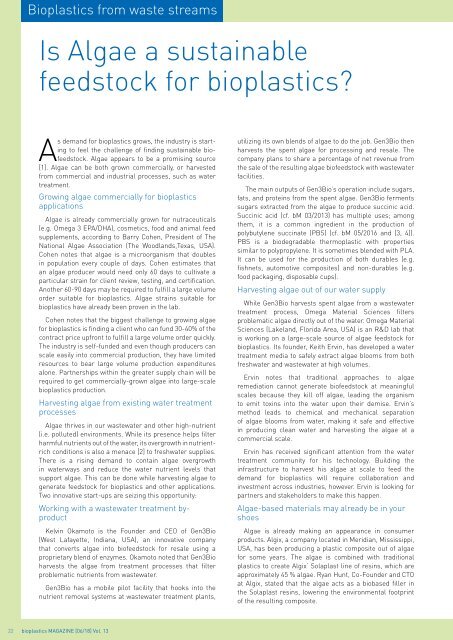Issue 06/2018
bioplasticsMAGAZINE_1806
bioplasticsMAGAZINE_1806
Create successful ePaper yourself
Turn your PDF publications into a flip-book with our unique Google optimized e-Paper software.
Bioplastics from waste streams<br />
Is Algae a sustainable<br />
feedstock for bioplastics?<br />
As demand for bioplastics grows, the industry is starting<br />
to feel the challenge of finding sustainable biofeedstock.<br />
Algae appears to be a promising source<br />
[1]. Algae can be both grown commercially, or harvested<br />
from commercial and industrial processes, such as water<br />
treatment.<br />
Growing algae commercially for bioplastics<br />
applications<br />
Algae is already commercially grown for nutraceuticals<br />
(e.g. Omega 3 EPA/DHA), cosmetics, food and animal feed<br />
supplements, according to Barry Cohen, President of The<br />
National Algae Association (The Woodlands,Texas, USA).<br />
Cohen notes that algae is a microorganism that doubles<br />
in population every couple of days. Cohen estimates that<br />
an algae producer would need only 60 days to cultivate a<br />
particular strain for client review, testing, and certification.<br />
Another 60-90 days may be required to fulfill a large volume<br />
order suitable for bioplastics. Algae strains suitable for<br />
bioplastics have already been proven in the lab.<br />
Cohen notes that the biggest challenge to growing algae<br />
for bioplastics is finding a client who can fund 30-40% of the<br />
contract price upfront to fulfill a large volume order quickly.<br />
The industry is self-funded and even though producers can<br />
scale easily into commercial production, they have limited<br />
resources to bear large volume production expenditures<br />
alone. Partnerships within the greater supply chain will be<br />
required to get commercially-grown algae into large-scale<br />
bioplastics production.<br />
Harvesting algae from existing water treatment<br />
processes<br />
Algae thrives in our wastewater and other high-nutrient<br />
(i.e. polluted) environments. While its presence helps filter<br />
harmful nutrients out of the water, its overgrowth in nutrientrich<br />
conditions is also a menace [2] to freshwater supplies.<br />
There is a rising demand to contain algae overgrowth<br />
in waterways and reduce the water nutrient levels that<br />
support algae. This can be done while harvesting algae to<br />
generate feedstock for bioplastics and other applications.<br />
Two innovative start-ups are seizing this opportunity:<br />
Working with a wastewater treatment byproduct<br />
Kelvin Okamoto is the Founder and CEO of Gen3Bio<br />
(West Lafayette, Indiana, USA), an innovative company<br />
that converts algae into biofeedstock for resale using a<br />
proprietary blend of enzymes. Okamoto noted that Gen3Bio<br />
harvests the algae from treatment processes that filter<br />
problematic nutrients from wastewater.<br />
Gen3Bio has a mobile pilot facility that hooks into the<br />
nutrient removal systems at wastewater treatment plants,<br />
utilizing its own blends of algae to do the job. Gen3Bio then<br />
harvests the spent algae for processing and resale. The<br />
company plans to share a percentage of net revenue from<br />
the sale of the resulting algae biofeedstock with wastewater<br />
facilities.<br />
The main outputs of Gen3Bio’s operation include sugars,<br />
fats, and proteins from the spent algae. Gen3Bio ferments<br />
sugars extracted from the algae to produce succinic acid.<br />
Succinic acid (cf. bM 03/2013) has multiple uses; among<br />
them, it is a common ingredient in the production of<br />
polybutylene succinate (PBS) (cf. bM 05/2016 and [3, 4]).<br />
PBS is a biodegradable thermoplastic with properties<br />
similar to polypropylene. It is sometimes blended with PLA.<br />
It can be used for the production of both durables (e.g.<br />
fishnets, automotive composites) and non-durables (e.g.<br />
food packaging, disposable cups).<br />
Harvesting algae out of our water supply<br />
While Gen3Bio harvests spent algae from a wastewater<br />
treatment process, Omega Material Sciences filters<br />
problematic algae directly out of the water. Omega Material<br />
Sciences (Lakeland, Florida Area, USA) is an R&D lab that<br />
is working on a large-scale source of algae feedstock for<br />
bioplastics. Its founder, Keith Ervin, has developed a water<br />
treatment media to safely extract algae blooms from both<br />
freshwater and wastewater at high volumes.<br />
Ervin notes that traditional approaches to algae<br />
remediation cannot generate biofeedstock at meaningful<br />
scales because they kill off algae, leading the organism<br />
to emit toxins into the water upon their demise. Ervin’s<br />
method leads to chemical and mechanical separation<br />
of algae blooms from water, making it safe and effective<br />
in producing clean water and harvesting the algae at a<br />
commercial scale.<br />
Ervin has received significant attention from the water<br />
treatment community for his technology. Building the<br />
infrastructure to harvest his algae at scale to feed the<br />
demand for bioplastics will require collaboration and<br />
investment across industries, however. Ervin is looking for<br />
partners and stakeholders to make this happen.<br />
Algae-based materials may already be in your<br />
shoes<br />
Algae is already making an appearance in consumer<br />
products. Algix, a company located in Meridian, Mississippi,<br />
USA, has been producing a plastic composite out of algae<br />
for some years. The algae is combined with traditional<br />
plastics to create Algix’ Solaplast line of resins, which are<br />
approximately 45 % algae. Ryan Hunt, Co-Founder and CTO<br />
at Algix, stated that the algae acts as a biobased filler in<br />
the Solaplast resins, lowering the environmental footprint<br />
of the resulting composite.<br />
22 bioplastics MAGAZINE [<strong>06</strong>/18] Vol. 13


















